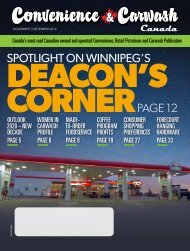CCWC mag Sept-Oct 2020_web
Create successful ePaper yourself
Turn your PDF publications into a flip-book with our unique Google optimized e-Paper software.
In the event a claim
is made due to an
accident or incident
on your property, it’s
important to notify
your broker or insurer
right away. A retailer
should expect to
provide a statement
and paperwork
detailing the extent
of damage to their
premises or goods.
as they arise. This includes parking lots,
walkways and entranceways. Things to look
for: potholes, cracks, deteriorating pavement
and damaged floor surfaces, poorly marked
ramps and staircases, inadequate lighting,
loose or missing handrails or slippery stairs.
2. Document your inspections and identify
any hazards, which creates a formal track
record that can be referenced should your
actions in creating a safe environment be
questioned.
3. Implement follow-up procedures and
create an action plan to ensure that any
identified hazards are fixed. Things to do:
repair or replace damaged floor materials,
apply appropriate cleaning solutions to avoid
unwanted residue, apply non-slip flooring
materials such as metal grills or heavy-duty
floor mats, apply slip-resident coating on stairs,
secure loose handrails and place cautionary
signage as needed, e.g. wet floor signs.
Various weather conditions can also create
risk for your location. From heavy rainstorms to
snowstorms, look for puddles or ice buildup on
sidewalks and entranceways and be sure to document
and engage appropriate snow removal and
de-icing services.
“Slips, trips and fall exposures present a unique
challenge in that site conditions can change frequently,”
says Hartle. “By understanding these
exposures and implementing risk mitigation
controls, a reduction in injuries to visitors can be
achieved.”
EMERGENCY RESPONSE PLAN
If you don’t have an emergency response plan, now
is the time to create one. It is important to identify
any risks issues or accidents that could occur
and the appropriate actions to prevent, resolve
and keep your business running in the event of a
disruption. These plans should be reviewed and
updated regularly and communicated with all
staff to confirm awareness and understanding.
It’s also equally important for staff to know where
safety equipment and supplies are stored and
how to properly use them, including first aid kits,
fire extinguishers and defibrillators.
INSURANCE
According to Economical Insurance, it’s important
for C&G retailers located across Canada to look
for a protection plan around slips and trips of
customers, and property coverage for damage
to the store, equipment or stock from accidental
crashes. This is commonly covered under a
commercial general liability policy. It’s typical for
coverage to vary between insurance companies
and therefore it’s important to review the details
of your policy with your insurance provider. For
example, gas station proprietors would need to
confirm that fuel pumps are covered under their
policy as this is something that may or may not
be covered by varying insurance providers.
In the event a claim is made due to an accident
or incident on your property, it’s important
to notify your broker or insurer right away. A retailer
should expect to provide a statement and
paperwork detailing the extent of damage to their
premises or goods. If a retailer is also in a position
where they are being sued in regards to the incident,
they will also need to share any legal materials
they’ve received and anything that might help
the insurance company to defend them, such information
from witnesses or surveillance footage.
C&G retailers can expect their insurance provider
to promptly investigate the claim to determine
the best plan of action; following the claim
assessment insurers will resolve the claim or defend
the claim in court if necessary, in the case of
a legal dispute.
The Insurance Bureau of Canada recommends
that policy holders apply risk mitigation strategies
and establish a relationship with your insurance
representative in order to receive the best
advice on having the right coverage for your business
needs and any applicable savings on your
premiums.
Slips, trips and crashes – these types of risks
can be best managed by keeping your premises in
a good state of repair, addressing issues as soon as
they arise, maintaining updated documents and
applying appropriate actions as soon as incidents
occur.
Don’t leave these situations to chance. Keep
Murphy’s law in mind and be prepared.
Meline Beach is a Toronto-based
communications practitioner and frequent
contributor to Convenience & Carwash Canada.
In addition to freelance writing, Meline provides
communications and public relations support to
businesses across Canada. She can be reached at
www.mlbcomms.ca.
48 / SEPTEMBER OCTOBER ISSUE




